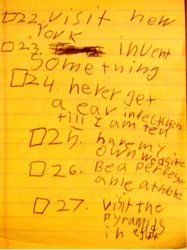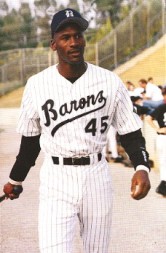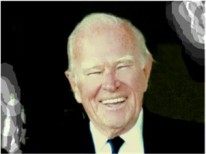I originally wrote this article for Lifehack.org in April 2007 (click here to view the original). With the new year upon us, I thought it would be appropriate to update and re-publish it here. Enjoy!
 Last February, on a rainy Saturday, my then seven year-old son (who was enjoying his budding ability to write) came to me with a small, yellow pad of paper and said, “Daddy, I want to write a list. What should I make a list of?” Suddenly, I recalled reading about John Goddard and the life list he wrote at age 15. His list consisted of 127 things he would like to do or see during his lifetime (for example: Climb Mt. Everest, run a mile in under five minutes, land on and take off from an aircraft carrier, and circumnavigate the globe). Goddard is now 75 years old and, at last count, has accomplished 109 of the goals he wrote as a teenager.
Last February, on a rainy Saturday, my then seven year-old son (who was enjoying his budding ability to write) came to me with a small, yellow pad of paper and said, “Daddy, I want to write a list. What should I make a list of?” Suddenly, I recalled reading about John Goddard and the life list he wrote at age 15. His list consisted of 127 things he would like to do or see during his lifetime (for example: Climb Mt. Everest, run a mile in under five minutes, land on and take off from an aircraft carrier, and circumnavigate the globe). Goddard is now 75 years old and, at last count, has accomplished 109 of the goals he wrote as a teenager.
“Why don’t you write a life list?” I suggested to my son. “OK,” he said. “What’s a life list, Daddy?”
In April, while I was tidying up my son’s room, I came across that yellow pad of paper. Since showing him John Goddard’s life list two months earlier, I hadn’t seen or thought about the pad. Behind the cover were nine pages of goals (55 total) he had written over the course of the last sixty days. Some were written in pencil, some in black ink, some in green ink – and all in the painstakingly careful handwriting of a second grader. As I read his life list, I could see his life unfolding before my eyes (not a life of achieving all of the goals on his life list, but certainly a life of adventurous striving).
Before I share highlights of my son’s life list with you, consider:
1. To what degree do you think a young person increases his chances of a fulfilling life by seizing the freedom to dream big, imagining what he wants to achieve, and writing it down?
2. Which habit would you wish for your child more than that of creating exciting mental pictures of the future with a spirit of expectancy?
Check out some of the excerpts of his list (I have corrected his spelling):
 #2: Run a marathon. #3 Visit the castles in Scotland. #7: Climb Mt. Washington (in New Hampshire). #9: Read a 200+ page book. #10: Live to be 105+ years old. #14: Set a record. #15: Be a dad. #17: Go water skiing. #19: Make something that goes in public. #21: Be able to speak more than two different languages. #23: Invent something. #24: Never get an ear infection until I’m ten. # 26: Be a professional athlete. #27: Visit the pyramids in Egypt. #30: Go to another continent. #35: Be in 125-degree weather. #36: Play 18 holes of golf in par or under par. #39: Be in the newspaper twice. #40: Never wear long sleeves to school on the first day. #43: Eat a wild food. #47: Visit a place on the equator. #48: Be in the hall of fame for any sport. #50: Rescue somebody on a real mission. #51: Win a championship game. #55: Visit any hall of fame for any sport.
#2: Run a marathon. #3 Visit the castles in Scotland. #7: Climb Mt. Washington (in New Hampshire). #9: Read a 200+ page book. #10: Live to be 105+ years old. #14: Set a record. #15: Be a dad. #17: Go water skiing. #19: Make something that goes in public. #21: Be able to speak more than two different languages. #23: Invent something. #24: Never get an ear infection until I’m ten. # 26: Be a professional athlete. #27: Visit the pyramids in Egypt. #30: Go to another continent. #35: Be in 125-degree weather. #36: Play 18 holes of golf in par or under par. #39: Be in the newspaper twice. #40: Never wear long sleeves to school on the first day. #43: Eat a wild food. #47: Visit a place on the equator. #48: Be in the hall of fame for any sport. #50: Rescue somebody on a real mission. #51: Win a championship game. #55: Visit any hall of fame for any sport.
Someday, my son will look back on this first life list he ever composed and laugh at some of the things he wrote – just as you laugh at some of them now. But he’ll also laugh at the many things he achieved, and realize that it was that rainy day back in 2007 when these accomplishments and experiences started hurtling towards him – and when his habit of shooting for the moon was born.
Postscript, January 1, 2008:
Today, for about an hour, I drove three of my kids around in our minivan while doing errands. In the spirit of New Year’s Day, I told them I’d record their “Life Lists for 2008” (yes, I did this while driving). Here’s what they came up with:
8 year-old boy (the one who wrote the life list last year, when he was 7): “I want to make the travel team (baseball), win the lottery, and get a new baseball glove.”
6 year-old boy: “I want to make a 20-foot high snowman.”
3 year-old girl: “I want to make a big snowman too!”
6: “And I want to go to Florida for one whole week, and I want to skate on Squam Lake.”
8: “I want to climb two 4,000-foot mountains.”
6: “I want to climb Mount Everest. And I want to climb every mountain in the universe!”
3: “I don’t want to climb any mountains, Daddy.”
8: “I want to live into the 22nd Century. And I want to be a major league baseball player, with a lifetime average of over .300.”
6: “I want to run all the way to Mount Everest. And I want to drive a car.”
8: “I want to see the castles in Scotland, and I want to run a marathon, and I want to do the Ironman triathlon, and I want to go to the Grand Canyon. I also want to be a dad.”
3: “And I want to be a mommy.”
6: “I want to be a kid. Being a grown up is hard work. So I want to be a kid.”
3: “I want to be a girl!”
8: “I want to be six-feet tall.”
3: “I want to be ten-feet tall.”
6: “I want to make an experiment where a cup breaks. And I want to swim to Florida. And I want to be rich so I can buy Mt. Everest and so I can buy the world.” [Why do you want to own the world? I asked. “Because it would just be fun,” he replied.]
3: “I want to have ten birthdays!”
8: “I want to go to Stonehenge.”
6: “I want to be so strong I could touch a tree and it would fall down.”
3: “I want to buy a happy Hanukah.” [This is totally random…. we are not Jewish, and we don’t celebrate Hanukah.]
8: “I want to get a baseball scholarship to college and to high school. And I want to be in the Baseball Hall of Fame.”
6: “I want to write a song, and I want everyone in the universe to hear it, and I want everyone in the universe to like it.”
3: “Me too, Daddy.”
Have you written your life list yet?






















